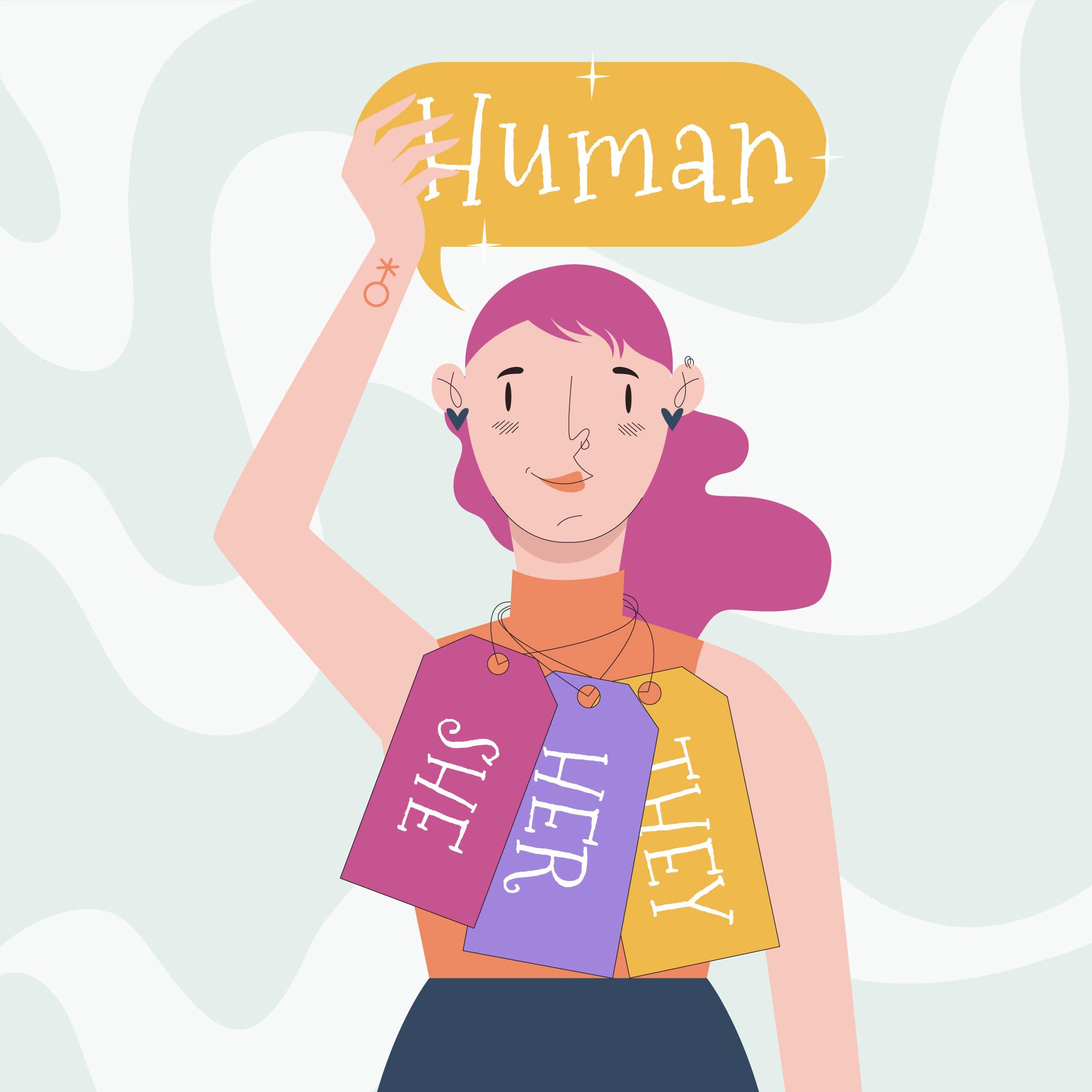 This guide produced by the Annie E. Casey Foundation defines some common terms — and promotes the use of accurate, authentic and inclusive language — to better equip adults to support LGBTQ youth, serve as their advocates and help them thrive.
This guide produced by the Annie E. Casey Foundation defines some common terms — and promotes the use of accurate, authentic and inclusive language — to better equip adults to support LGBTQ youth, serve as their advocates and help them thrive.
Sexual and Gender Identity Terms to Know
Agender
Describes a person who does not identify as male or female or some combination of male and female. Some agender individuals see themselves as genderless, while others see themselves as gender neutral.
Ally
Describes a person who supports, both publicly and privately, the LGBTQ community and equality in its many forms. Heterosexual and cisgender people can be allies, as well as individuals from within the LGBTQ community.
Asexual
Describes a person who is not sexually attracted to others and has no desire to engage in sexual behavior. Asexuality differs from celibacy in that a person who is celibate is sexually attracted to others but chooses to abstain from sex. Sometimes, asexual is abbreviated as “ace.”
Bigender
Describes a person who has two genders. People who are bigender may experience two gender identities at the same time or at different times. These gender identities can be binary — male and female — or include nonbinary identities.
Bisexual
Describes a person who is attracted to both men and women. A person does not need to have had specific sexual experiences — or any sexual experience — to identify as bisexual.
Cisgender
Describes a person whose gender identity matches the sex — male or female — originally identified on their birth certificate (i.e., people who are not transgender). Cisgender, which is pronounced sis-gender, describes only a person’s gender identity — not their sexual or romantic attractions. Sometimes, cisgender is abbreviated as “cis” in casual conversation.
Coming Out
Describes the process of a person first coming to understand their own sexual orientation, then revealing it to others. However, it is not necessary to have sexual experiences or to even tell others in order to come out. One may be out to just one’s self. Coming out is often correlated with rates of youth homelessness.
Enby
Describes a person who does not identify as exclusively male or exclusively female and usually prefers“they” as a pronoun. Enby is the phonetic pronunciation of“NB,” which stands for nonbinary. Not all nonbinary individuals prefer or use this term.
Gay
Describes a person who is attracted, emotionally and/or physically, to someone of the same gender. The term can be used by men, women or individuals who identify as nonbinary. A person does not need a specific sexual experience — or any sexual experience — to identify as gay.
Gender
A social construct used to classify a person as a man, woman or some other identity. Fundamentally different from sex assigned at birth, gender is often closely related to the role that a person plays or is expected to play in society.
Gender Affirming Surgery
A surgical procedure that enables an individual’s body to be more congruent with their gender identity. Also referred to as sex reassignment surgery or gender confirming surgery.
Gender Dysphoria
Describes the extreme discomfort that a person feels because their assigned sex at birth does not match their gender identity. This sense of unease or dissatisfaction can cause depression and anxiety and negatively impact an individual’s daily life.
Gender Expression
How individuals communicate their gender to others through their clothing, speech, mannerisms and other factors. Gender expression is not the same thing as gender identity. A person can express one gender yet identify with another.
Gender Fluid
Describes a person whose gender expression or gender identity — or both — changes over time. Not everyone whose gender identity or expression changes identifies as gender fluid.
Gender Identity
A person’s internal identification as male, female, something in between or something other than the two conventional gender options. A person’s gender identity is not visible to others and can match or differ from their assigned sex at birth.
Gender Neutral
Describes not identifying as being of a particular gender. It can apply to several different aspects of life. People who identify as gender neutral typically don’t subscribe to gender stereotypes and may use the pronouns “they/them/their” as well as others.
Gender Nonconforming
Describes a person who does not adhere to the traditional expectations — in terms of their appearance or behavior — of their assigned gender. Some of these individuals identify as transgender but others, for example, masculine lesbians, do not.
Heterosexual
Describes a person who is attracted — physically and emotionally — to individuals of the opposite sex. Otherwise known as a straight person.
Homosexual
Describes a person who is attracted — physically and emotionally — to people of the same sex. This term is outdated and disfavored in the LGBTQ community, as it was commonly used to ostracize others.
Intersex
Describes a person born with sex characteristics that are not typical for male or female bodies. Sex characteristics are physical features relating to sex — including chromosomes, genitals, hormones and other reproductive anatomy — as well as secondary features that emerge from puberty. Intersex is an umbrella term, and intersex characteristics and traits are not always apparent or identified at birth. The “I” in the longer version of LGBTQ (LGBTQIA+) stands for intersex.
Lesbian
Describes a woman who is attracted, emotionally and/or physically, to other women. A woman does not need a specific sexual experience — or any sexual experience — to identify as a lesbian.
LGBTQ
An acronym used to describe lesbian, gay, bisexual, transgender, queer or questioning persons or the community. Avoid using the term“gay community,” as it does not accurately account for the community’s diversity.
Nonbinary
Describes a person whose gender identity falls outside of the two-gender construct (male or female). For example, nonbinary can describe an individual whose gender changes over time, who does not identify as male or female or who associates with elements of both genders. Some individuals who identify as nonbinary prefer the term enby.
Pansexual
Describes a person who is attracted to — or has the potential to be attracted to — people of any gender or gender identity. This attraction can be emotional or physical.
Queer
An adjective used by some people, particularly younger people, whose sexual orientation is not exclusively heterosexual. Queer was once used a pejorative term and has been reclaimed by some — but not all — members of the LGBTQ community.
Questioning
Describes a person who is still discovering and exploring their sexual orientation, gender identity, gender expression or some combination thereof. Using this term enables an individual to identify as part of the LGBTQ community while avoiding other labels and recognizing that their process of self-identification is still underway.
Sex
The classification of a person as male or female. At birth, babies are assigned a sex that typically corresponds with their external anatomy. Yet an individual’s sex is influenced by a larger combination of factors, including their chromosomes, genes, hormones, reproductive organs and secondary sex characteristics.
Sexual Orientation
An enduring emotional and/or physical attraction (or non-attraction) to other people. Sexual orientation is fluid and encompasses a variety of labels, including gay, lesbian, heterosexual, bisexual, pansexual and asexual.
SOGIE
An acronym for sexual orientation, gender identity and gender expression. Every person has a sexual orientation, gender identity and gender expression.
Straight
Describes a man who is attracted to women or a woman who is attracted to men. Can be used as a synonym for heterosexual.
Transgender
Describes a person whose gender identity and/or gender expression do not match their assigned sex at birth. Transgender people may be straight, lesbian, gay, bisexual or queer.
<
Transgender (or Trans) Man
Describes a person who was assigned a female sex at birth but identifies as male. This person may or may not actively identify as trans.
Transgender (or Trans) Woman
Describes a person who was assigned a male sex at birth but identifies as female. This person may or may not actively identify as trans.
Transition
A complex process by which transgender people align their anatomy (medical transition) and gender expression (social transition) with their gender identity. Transitioning is a multiple-step process that occurs over a long period of time. It can include such steps as using a different name, using new pronouns, dressing differently, updating legal documents, hormone therapy and surgery. The exact steps involved in a person’s transition varies.
Two Spirit
Describes a person who identifies as having both a masculine and a feminine spirit. It is used by some Native American and Alaska Native people to describe their sexual, gender and/or spiritual identity. It may encompass same-sex attraction and also include relationships that could be considered poly.







